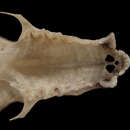en
names in breadcrumbs


Glossophaga soricina has several morphological features that have been interpreted as adaptations for nectivory: a long, extendable tongue for probing into flowers; divergent hair scales that hold pollen grains; and specializations in digestive physiology to facilitate digestion of nectar and pollen. G. soricina is known to carry a variety of endoparasites (cestodes, nematodes and protozoans) as well as at least 34 ectoparasites.
Perception Channels: tactile ; chemical
There are no indications that G. soricina is threatened at present.
IUCN Red List of Threatened Species: least concern
This species is probably important as a pollinator of flowers and disperser of seeds of economically important plant species.
Pollen, nectar, flower parts, fruit, insects. Glossophaga soricina is known to consume parts of at least 34 different species of plants and shows clear preferences locally.
Northern Mexico to Paraguay and northern Argentina, Jamaica, Bahamas.
Biogeographic Regions: neotropical (Native )
Foraging habitat for G. soricina is described as moist and open.
Terrestrial Biomes: forest ; rainforest
Average lifespan
Status: captivity: 10.0 years.
The average weight of of 6 adults from north coast of Colombia is 9 g; average weights of 10.5 g have been reported for other populations. Average forearm skull lengths for 4 males from Nicaragua are 36.4 and 21.45 mm, respectively. The same measurements for 4 females from Nicaragua are 35.75 and 21.3 mm.
Other Physical Features: endothermic ; bilateral symmetry
Average mass: 9.6 g.
Average basal metabolic rate: 0.164 W.
Reproductive behavior varies somewhat geographically, though most accounts indicate that G. soricina either breeds continuously throughout the year or is bimodally polyestrous. Gestation lasts approximately 3.5 months. Normally only single offspring, but twins have been reported. Parturition occurs with the young in the head down position. Young cling cross-wise to the mother's ventral surface with the head just posterior to the mother's throat. Young have been obsereved hanging on their own at 18 days, but they are known to remain attached to their mother as late as 20 days old. Flight begins at about 25 to 28 days after birth.
Key Reproductive Features: gonochoric/gonochoristic/dioecious (sexes separate); sexual
Average gestation period: 106 days.
Average number of offspring: 1.
Pallas's long-tongued bat (Glossophaga soricina) is a South and Central American bat[2] with a fast metabolism that feeds on nectar.
It has the fastest metabolism ever recorded in a mammal, similar to those of hummingbirds. Although it uses 50% of its stored fat over the course of a day, over 80% of its energy comes directly from the simple sugars that compose its diet of nectar, without being stored in any form.[3] It will also feed on pollen, flower parts, fruit and insects.[4]
A 2013 study determined that their tongues have a mopping ability that is powered by blood, a phenomenon unique in nature. Elongated hairs at the tongue's tip, which normally lie flat, become engorged with blood when the tongue is protruded. As a result, the hairs stand in erect rows, perpendicular to the tongue. The tongue tip increases by over 50 percent in length, contracting its width to squeeze enlarged vascular sinuses along the tongue's length, that are directly connected to the hairs. During this process tissue capillaries turn from pink (little blood) to dark red. The blood vessel networks that enter the tip of the tongue are fringed by muscle fibers, which contract to compress the blood vessels and displace blood towards the tip. The efficiency of this feeding mechanism is believed to enable the bats' survival on limited food sources.[5]
Pallas's long-tongued bat (Glossophaga soricina) is a South and Central American bat with a fast metabolism that feeds on nectar.